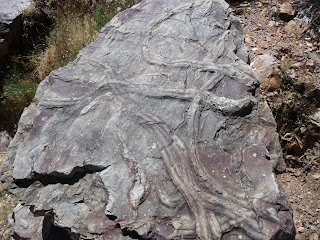May 31st ~ Guarda – Municipal Campismo
Awoke early to an unbelievable dawn chorus of birdsong, probably hoopoes, bee-eaters and azure winged magpies, as these are the cries we don’t know, but know the birds are in this area. Another scorching day in prospect, possibly reaching 40⁰ C in the full midday sun. We drove to Idanha-a-Velha, which was once a major Roman city known as Igaetania. During the 15th Century, it is said that a plague of rats forced the villagers to move to Monsanto (see next visit).
The village looks much the same as when the rats moved in, and not much different to when the Romans left either. Massive Roman walls remain intact, and the Roman bridge .... just a series of stepping stones ...remains in use to this day (see pic). Roman relics including sarcophagus’ and inscribed blocks of stone lie strewn about the village. The locals were friendly, and ensured we didn’t miss the Roman Bridge.
On to Monsanto, which claims to be the most ancient settlement in Portugal, although Idanha-a-Velha is probably older. We drove to the upper carpark, and walked through the village which is built into the crags of the mountain, up to the castle constructed as part of the huge rocky outcrop. Some of the streets are carved out of the rock, barely wide enough for a mule.
We reached the summit of the castle in blazing heat, which had also triggered swarms of tens of thousands of flying earwigs , which were a nuisance. Returning from the summit, they soon cleared, although the lady in the cafe where we had lunch told us that they had engulfed the village the day before.
On to Penha Garcia, a small village 7 km away, and extraordinarily not in the guidebooks. The lady in the cafe had told us it was a “must see”.The Turismo was closed for lunch, so we climbed up to the Church and the start of the 3km “fossil walk”. The village overlooks a rocky valley of layered rocks at unusual angles, and is located where 2 tectonic plates collided and formed these formations, including ancient fossils in the rocks. We foolishly started the walk @ 2pm in temperatures of between 35-40⁰C, and walked down to an old watermill, which had a small pool nearby, which Chris took off his tee shirt to soak and put on, in order to conserve enough drinking water for Jackie. We cut short the walk , due to the heat, and climbed back to the village, only to find an old lady singing and playing an “Adufe”, a double skinned square drum, a true symbol of the local identity.
On to Sabugal, which was quite disappointing, as the Castle was closed (open Tues-Sun), and appeared to have been totally restored.
Drove the last lap to Guarda, which claims to be the highest City in Europe @ 1,007 metres , nearly 3,500’. Quite a big city, but we managed to find the Municipal campsite, which for some reason was pretty full. Showered and changed , and went for a walk and meal, as had irritated fellow campers by camping in their perceived domain. Guarda is quite austere, with grey stone walls and a huge block Sé (Cathedral) where a service was in progress. Brought Richard 1,000 fags, and asked the tobacconist where to eat, who directed to us a Restaurant ( Restaurante Tucha, 2mins west of Se) where we had a fantastic meal at a budget price of 28 euros inc pre-prandial drinks, olives, bread, two main meals and a bottle of wine.






0 Comments:
Post a Comment
<< Home